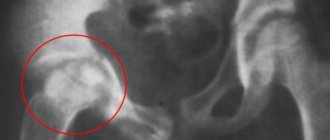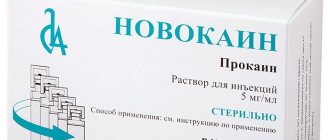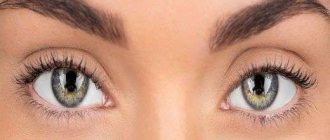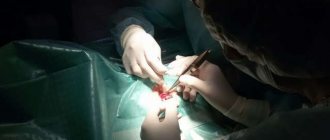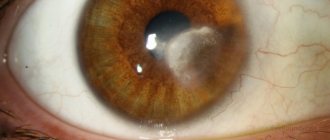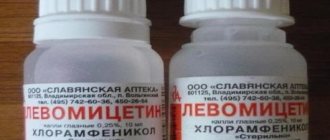Chlorhexidine, or Chlorhexidine digluconate, in the language of pharmacists, is a popular antiseptic widely used in medicine. It is usually used to treat stomatitis and ENT diseases. The solution quickly destroys pathogenic microflora, relieves pain, inflammation and prevents recurrent infection. Patients who have tried it at least once no longer want to switch to another antiseptic drug for infections of any origin. But is it possible to wash your eyes with Chlorhexidine for conjunctivitis, blepharitis and other infectious eye diseases?
Note: Chlorhexidine is a fairly new antiseptic that only recently appeared in the home medicine cabinets of our compatriots, replacing the traditional iodine and brilliant green. The drug was discovered in the middle of the last century in Great Britain. It was not immediately used to treat various fabrics and surfaces for the purpose of disinfection, since the properties of this substance were little studied. But now Chlorhexidine is a favorite antiseptic drug for versatile use for many doctors and patients.
Description, composition and properties
Chlorhexidine is a broad-spectrum antibacterial drug. It is active against almost all groups of bacteria and is able to inhibit the growth of fungi and even some viruses - for example, the herpes virus. It is less effective than Miramistin. But this substance also has fewer contraindications.
Some believe that Miramistin and Chlorhexidine are the same thing. But in fact, although the drugs can be considered similar in action, they contain different active substances
If we talk about the chemical composition, this drug belongs to the group of biguanide derivatives containing chlorine. Chlorhexidine for eyes is available in pharmacies in the form of bigluconate. The mechanism of action of the drug is due to its interaction with bacterial cell membranes. The active substance reacts with phosphates on the surface of cells, as a result of which the membranes are destroyed and pathogenic microorganisms die.
Chlorhexidine is advisable to use to treat infections caused by the introduction of gram-positive or gram-negative bacteria, some fungi (although most fungal spores are resistant to the drug) and viruses. The substance does not affect the life activity of lactobacilli. When applied topically, Chlorhexidine practically does not enter the general bloodstream, but in the area of application it remains active for a long time. For this reason, doctors love to use Chlorhexidine solution to disinfect hands during examination of a patient and perform various manipulations.
Chlorhexidine solution is a deep pink liquid, available in various concentrations: 0.01%, 0.02%, 0.05%, 0.2%, 0.5%, 1.0%, 2.0%, 5 .0%. In medicine, a solution with a concentration of 0.05% is usually used to treat wounds, skin and mucous surfaces. The solution is available either in plastic bottles with a dropper attachment, or in glass bottles with a screw cap. The bottles are packaged in cardboard boxes with instructions for use.
You can also find this drug in other pharmaceutical forms in pharmacies:
- ointment;
- cream;
- gel;
- spray;
- vaginal suppositories.
In ophthalmology, an aqueous solution of the lowest concentration is used.
For information: when heated and at high temperatures, the effectiveness of Chlorhexidine increases, but if the temperature exceeds 100 degrees, the substance begins to partially decompose. The presence of pus and blood somewhat reduces the activity of the drug, however, it quickly stops the process of suppuration and helps to heal bleeding wounds that are difficult to treat.
What to wash with?
How can you clean a dog’s eyes if they are festering, as well as for hygienic purposes? At home, the following solutions are suitable for washing your dog's eyes:
Sterile saline sodium chloride solution 0.9%In small ampoules its cost is 25-30 rubles. You can purchase a bottle with a volume of 100 ml or more, provided that sterility is maintained during use. The price of a bottle is from 30 to 50 rubles. |
FuracilinReady solution. It is a good antiseptic and is used to wash the dog’s eyes both in the treatment and prevention of inflammation of various types. A ready-made solution for eye treatment can be purchased at a pharmacy to order. Pills . You can prepare an aqueous solution in a ratio of 1:5000 (this is exactly the concentration that is needed) at home. To do this, one tablet of furatsilin (20 mg) is diluted in 100 ml of sterile warm or hot distilled water. The solution is considered ready when the active substance is completely dissolved and nothing settles at the bottom. The cost of one package of furatsilin tablets ranges from 50 to 80 rubles. |
Chlorhexidine solutionPharmacies sell a solution with a concentration of 0.05%. Dogs can have their eyes washed with a 0.01% chlorhexidine solution. To prepare the required concentration, take 4 ml of 0.05% chlorhexidine solution into a sterile 20 ml syringe and dilute to 20 ml with sterile saline. Cost 20 rubles. |
You can brew chamomile flowers to treat your eyes.It is more convenient to purchase dry chamomile in special filter bags. Place 1 sachet in a glass of hot water and leave for 15-20 minutes. The solution can be used after cooling it first. The cost of one package is about 60 rubles. |
Black teaThis is one of the most popular and always available eye cleansers. A weak brew, prepared the day before the intended use, is better suited, that is, it is not recommended to use freshly brewed tea. |
Area of application of the drug
In medicine, Chlorhexidine has found wide application. First of all, the drug is used to treat skin and mucous membranes for lesions of varying nature and severity. Doctors also use it to disinfect hands, instruments and work surfaces. Since the drug contains chlorine and can cause burns to the mucous membrane, the instructions for use do not recommend using it to wash the organs of vision.
Concentrated Chlorhexidine solution can be used to disinfect hands and instruments, as well as to prepare a low-concentration eye wash solution
But in practice, a person’s eyes are washed with the lowest concentration of Chlorhexidine for conjunctivitis and other infectious eye diseases. You should ask the pharmacy for an aqueous solution of Chlorhexidine at a concentration of 0.02% or 0.05%. Some mothers have gotten used to preparing a solution of the required concentration on their own, but it is better not to take risks, but to find a ready-made preparation.
Why do you need to rinse your dog's eyes?
Your dog's vision needs to be monitored daily.
. This will help to identify and prevent the development of eye diseases of bacterial and viral origin at an early stage. Which can be dangerous and can affect the animal’s body as a whole. Tea removes redness well, relieves eye swelling and fatigue.
Such procedures are especially useful for long-haired breeds of dogs, those whose hair falls over their eyelids (lapdogs, Yorkies, Giant Schnauzers, Bobtails and others). If hair gets in their eyes, their eyes may water.
It can be heard saying that the eyes are “running”. Eye discharge is a signal that the dog is not healthy. This may be due to viral diseases, colds, digestive tract or metabolic disorders. You can't cope here with tea alone. It is necessary to reconsider the animal's diet. Feed your dog a balanced diet and this problem can be avoided.
If you suspect that chemicals, dust or sand (earth) have gotten into your dog's eyes, provide first aid! Wash your four-legged friend's eyes with any tea solution.
If an animal has an eye disease and the doctor has prescribed eye drops, then tea rinsing is a necessary procedure before using medications.
How to use the drug correctly
So, high concentration Chlorhexidine is not suitable for dripping directly into the conjunctival sac. A solution of even the lowest concentration can cause severe chemical burns to the mucous membrane and damage to the cornea. But you can instill it in diluted form, wipe the eyes of a child or adult, and also use it as antiseptic eye drops to wash the eyes.
How to do it correctly:
Antiseptic eye drops
- Before instillation, be sure to rinse your eyes to remove purulent discharge and crusts. For this purpose, use warm boiled water, chamomile decoction or a weak solution of furatsilin, cotton pads or swabs. Then Chlorhexidine is diluted with warm boiled water. For an adult, a concentration of 1:1 is sufficient. For children, the concentration should be two times lower. The drug is injected into the conjunctival sac, slightly retracting the lower eyelid, in the amount of 2-3 drops. The frequency of administration of the drug per day is no more than 3 times.
- To clear pus from the eyes, Chlorhexidine is first warmed to body temperature. The eyes should be treated with a cotton swab dipped in a solution of Chlorhexidine. If your child's eyes are washed, you should first test the effect of the drug on yourself. If the solution is too concentrated, it is diluted with water. It is forbidden to pour even a diluted solution into your eyes - this can cause a burn. You can rinse and clean your eyes with a diluted solution up to six times a day.
If undiluted Chlorhexidine gets on the mucous membranes, you should immediately rinse them with cool water and, if necessary, consult a doctor. If a solution of such concentration is accidentally swallowed by children, nothing bad will happen either. Just let your child drink more water. You need to call a doctor or go to the clinic only if atypical, severe symptoms of poisoning occur - nausea, vomiting, headaches, etc.
Advice: sometimes it is not possible to find a ready-made aqueous solution of Chlorhexidine in a pharmacy; only concentrate is offered. You can bring it to the required concentration yourself using boiled water and a syringe - it is more convenient for them to measure the required amount of the drug. A special table will help you figure out the proportions - it’s easy to find on the Internet. The prepared solution is stored in the refrigerator in a tightly closed bottle; the product should be warmed up before use.
A special table will help you prepare your own solution of the required concentration
How to wash your eyes?
Step 0. Prepare inventory.
Select and prepare an eye wash solution. Prepare sterile gauze pads or clean cotton pads.
Step 1. Catch and record the animal.
If you have a small, nimble dog, wrap it in a towel or put it in a narrow carrier from which one head will stick out. A large or calm dog can be placed in a bathtub or sink.
Step 2. Wash your hands thoroughly with soap!
Step 3. Soak the crusts
Wet a napkin in the prepared solution and soak closed eyelids and the contaminated area around them for several minutes. Then painlessly and carefully remove the soaked crusts from the wool. If after this the eye does not open and is still closed, do not try to open it yourself. Contact your ophthalmologist!
Step 4. Rinse the eye.
It is more convenient to rinse the eye, or rather the cornea and conjunctiva, using a sterile 20 ml syringe with the needle removed, a clean syringe, or a napkin generously soaked in the solution. Draw up the rinsing solution. Using the thumb and index finger of your left hand, spread your eyelids (call your neighbors to hold your nimble head). It is better to apply the solution to the upper outer corner, in which case it will wash the entire surface of the cornea and conjunctival sac. When using a generously moistened cloth, the latter can be used to gently wipe the conjunctiva.
If during rinsing you notice foreign, indelible particles lying on the surface of the eye or in the folds of the conjunctiva, do not touch or try to remove it yourself, immediately run to the doctor!
Step 5. Complete the procedure.
Finally wipe the eye area, eyelids and fur with a dry cloth from the outer to the inner corner of the eye.
Contraindications for use and side effects
A high concentration solution is not recommended for the treatment of:
- children under 12 years of age;
- pregnant and lactating women.
Chlorhexidine is prescribed with caution to persons prone to allergic reactions and with poor tolerance to medications.
With frequent and prolonged use of the solution, the following undesirable side effects may occur:
- dry mucous membranes;
- redness, itching, irritation;
- photophobia;
- skin rashes.
Unpleasant symptoms usually go away after adjusting the dosage of the drug or stopping it. If symptoms worsen, you should consult a doctor as soon as possible.
Increased redness and irritation of the mucous membranes of the eyes, itching, lacrimation, which do not go away even half an hour after the administration of Chlorhexidine, may be symptoms of individual intolerance to the drug
What do you need to know about washing your eyes with Chlorhexidine solution for conjunctivitis?
In the process of treating conjunctivitis with this medication, it is important to follow certain rules that will allow you to achieve the desired result in a shorter period of time. So here it is:
- It is necessary to rinse the inflamed organs of vision with this liquid, the temperature of which will be slightly above room temperature.
- During the treatment procedure, the eyes must be closed. If the medicine does get on the mucous membrane, there is no need to panic. In this case, you need to immediately do additional rinsing of the organ of vision, otherwise you may get a chemical burn to the conjunctiva.
- Using a cotton swab, gently move from the outer corner of the eye to the inner corner to remove accumulated pus.
- This procedure is performed at least 5 or maximum 6 times per day.
- To treat conjunctivitis in adults, the eyes are washed with a 0.10% solution of this medication, and sick eyes in children are washed with a solution of 0.05%.
You may be interested in: How to use Oftalmoferon for conjunctivitis?
What else is important to know
Typically, Chlorhexidine solution combines well with other medications. But in some cases caution should be exercised.
- The substance does not combine with soap, since soap is alkali, and Chlorhexidine contains chlorine. Before carrying out the necessary manipulations, you should definitely wash your hands with soap, but then you need to rinse them well under running water and wipe them thoroughly dry. If Chlorhexidine solution is used to disinfect hands, then you should no longer wash them with soap.
- The drug interacts with such a popular home antiseptic as iodine. The simultaneous use of two medicines may cause skin dermatitis.
- When combined with ethyl alcohol, the therapeutic effect of Chlorhexidine is enhanced. For this reason, predominantly an alcohol solution of the drug is available in pharmacies. But for the same reason, it is not recommended for use in pediatrics and for the treatment of women during the period of bearing and feeding a child.
An opened bottle or container with a solution prepared independently is stored in the refrigerator for no more than one week. Then the remaining product should be disposed of and a new portion should be prepared. When sealed at a temperature not exceeding 25 degrees Celsius, it can be stored for up to three years without losing its properties.
An analogue of Chlorhexidine solution for the eyes are Miramistin or Okomistin drops.
Summary: Chlorhexidine is a relatively new broad-spectrum antiseptic drug. It is used as a disinfectant for treating purulent wounds, skin and mucous membranes, disinfecting hands and medical instruments. Since the substance contains chlorine, it is not recommended for use in ophthalmology: Chlorhexidine can cause burns to the cornea. But if you dilute the drug with water to a weak concentration, you can wash your eyes with it for purulent conjunctivitis and other infections caused by the introduction of bacteria, some fungi and viruses. The medicine is available in pharmacies without a doctor's prescription. But this does not mean that it can be used uncontrolled; consultation with an ophthalmologist before starting a course of treatment is necessary, especially if we are talking about children under 12 years old, pregnant or lactating.
What exactly should you use to wash your pet's eyes?
There are several solutions that you can prepare yourself:
physiological, 0.9% sodium chloride solution, sterile
2% boric acid solution
chamomile decoction (brew 1 bag of dry chamomile (or 1 tablespoon of chamomile flowers) in a glass of boiling water, leave for 20 minutes and be sure to cool.
green tea (brew as for drinking, cool).
"Veterinary Bulletin" No. 2 / 2012
Every owner wants his dog to always be beautiful and active. An indisputable fact is that only a healthy dog can be beautiful.
Eyes are the mirror of a dog's soul. Vision means a lot to a living being. The eyes are an important organ and should always be clean and well-groomed.
The structure of a dog's eye is similar to a human's. They consist of the cornea, lens and retina. Nature has made sure that the eyes clean themselves. For this purpose, there is a third eyelid and lacrimal glands.
However, animals, unlike people, cannot take care of their eyes on their own. Plant pollen, dust, microparticles, chemicals, smoke and other natural (atmospheric) phenomena have a negative impact on dog vision.
A competent and caring owner should regularly “wash” his dog. Rubbing a dog's eyes with running water is strictly contraindicated! There are other folk and medical methods for this procedure. The most popular of which is the familiar regular tea!

